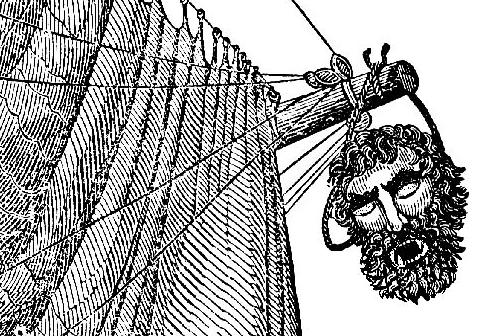
Historical Tales | News | Vampires | Zombies | Werewolves
Virtual Academy | Weapons | Links | Forum
Yo-Ho-Ho and a Bucket of Blood
 |
|
"I personally saw him...rip the heart from one man's chest..." |
So wrote Jacob Hensleigh, a sailor discovered by the British Navy clinging to a piece of driftwood in the Mediterranean Sea. As the only survivor of one of the last attacks by the legendary vampire-pirate Redbeard, Hensleigh was indeed a lucky man: between the years 1795 and 1797, Redbeard and his crew killed an estimated 500 sailors and paralyzed shipping on the Mediterranean.
Redbeard was born James Wyatt around 1778 in London, England. As a boy, he would spend hours hanging around the docks of east London and dreaming of the day when he would first set sail. That day came for him at age 15, when he joined the crew of a merchant vessel. Always a quick study, Wyatt rose swiftly through the ranks, and by age 25 he was the captain of his own ship, a beat-up sloop he sardonically called the Carcass. When England declared war on France in 1793, Wyatt had the Carcass retooled for battle and offered his services as a privateer for the Royal Navy. His job was to board and plunder any ships carrying supplies between France and her ally, Spain. The barrel-chested, six-foot-five-inch Wyatt proved to be a natural leader and his crew became such efficient plunderers that Napoleon himself put a bounty on their head. But Wyatt's days of service to the English crown came to an end in the summer of 1795, when he was bitten by a vampire outside a waterfront pub in Gibraltar. Wyatt quickly spread the virus to his crew and soon the Carcass was sailing under the direction of about 50 bloodthirsty vampires.
 |
|
Redbeard sailed under a blood-red Jolly Roger |
Each night, the Carcass would set sail from the castle flying a blood-red Jolly Roger from its mast. Exploiting their night vision, Redbeard and his crew would identify a ship, slip up alongside it and board while most of the sailors were still sleeping. The crew of a single ship could supply enough blood to feed Redbeard's vampires for a month. Those unfortunate crew members who weren't bitten right away would be taken back to the castle and imprisoned in the dungeon to await a grisly fate.
 |
| Nelson's ships besiege the pirate hideout |
 |
|
An ignominious journey back to London |
In early June, a dozen warships under the command of Nelson sailed around the head of the Iberian peninsula and into the Mediterranean. For six weeks, the fleet searched in vain for Redbeard along the north African coast. Finally, on July 12, they plucked the terrified Jacob Hensleigh from the waters and knew they were close. A day later, the fleet boarded a ship and found it littered with bloodless, dismembered body parts. The next night, the fleet came across Redbeard's army in the midst of an attack on a fishing boat. They surrounded the vampire ships and a brutal battle ensued, during which Nelson took a bullet to the arm. The English lost three ships and scores of men in the battle, but they fought on, knowing that time was on their side.
With dawn starting to lighten the eastern horizon, Redbeard was forced to pull back and make for safe harbor. The English fleet followed him all the way to the castle and began several hours of relentless bombardment. That afternoon, 500 troops went ashore to finish the job. Redbeard and a few of his closest associates retreated to the dungeon, where, despite being vastly outnumbered, they put up a ferocious fight. In all, it took three days to secure the castle. The troops then freed several dozen prisoners and burned the vampire compound to the ground.
When Nelson's men returned with Redbeard's head, Nelson had them hang it from the bowsprit at the front of the ship for the journey back to England. As they triumphantly made their way up the Thames to London, huge crowds gathered along the riverbanks to watch. Nelson presented Redbeard's head to King George III, who had it placed on a stake on London Bridge, not far from where a boy named James Wyatt had first gazed west and dreamed of a life at sea.